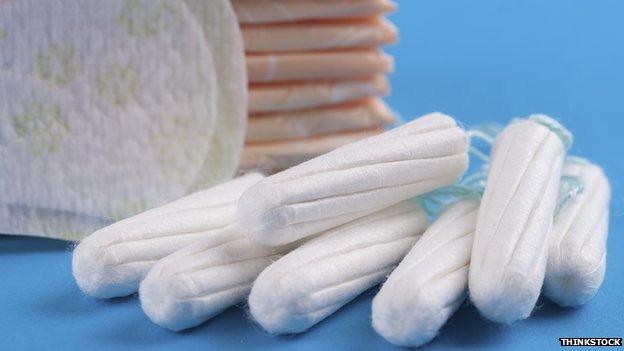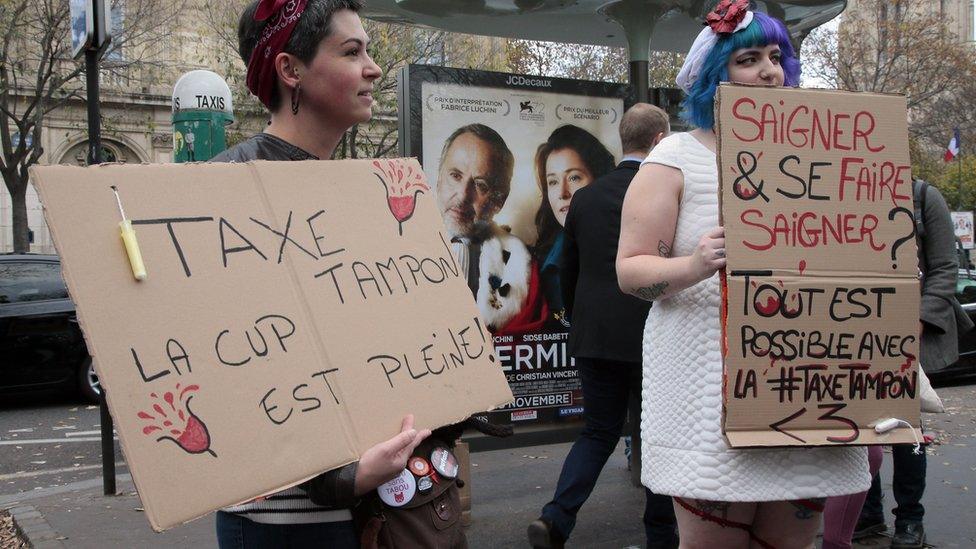Why is the US 'tampon tax' so hated?
- Published

California Governor Jerry Brown has vetoed a bill to end a sales tax on feminine hygiene products, a levy that has sparked worldwide debate.
The so-called tampon tax is a sales tax on feminine hygiene products which are used to absorb menstrual blood.
Necessities such as food and medicine are exempt from the tax, but some states do not include tampons and pads.
Advocates have decried the tax as an unfair burden on women since tampons are not considered a luxury.
The Democratic governor cited fiscal concerns over his decision to block the bipartisan bill.
Tampon tax paid around the world
"Each of these bills creates a new tax break or expands an existing tax break," Mr Brown said in a statement.
The governor also vetoed several similar bills, including one to end tax on nappies, arguing the measures would reduce state revenue by $300m (£227m) in the coming year.
Assemblywoman Cristina Garcia, who authored the bill, lambasted the veto, vowing to "keep pushing until we get it done".
Is there a law taxing female hygiene products?
There is no "tampon tax" which specifically is pointed at feminine products, but many US states do not exempt the product from the regular state sales tax.
The average statewide sales tax is 6.25%, but in some cases, can run as high as 10.25% like in Chicago, due to city and county surcharges.
Why has there been a backlash?
The tampon tax debate has gained momentum as a global movement in part due to a social media push to end the stigma surrounding menstruation through hashtag campaigns such as #HappyToBleed and #FreeTheTampons.
In 2015, a London woman went viral after she ran the marathon without using feminine hygiene products to draw attention to the issue.
'Tampon tax': How much do women pay for periods?
The same year, Republican Donald Trump stirred controversy after he referred to Fox News debate moderator Megyn Kelly as having had "blood coming out of her wherever," prompting the hashtag #PeriodsAreNotAnInsult.
President Barack Obama also underscored the issue when he said he had "no idea" why tampons were taxed as a luxury item in some states earlier this year.

Which states have a tax on tampons?
Just 13 of the 50 US states have no tax on feminine hygiene products.
Minnesota, Maryland, Massachusetts, New Jersey and Pennsylvania do not tax sanitary products
Oregon, Montana, Delaware, New Hampshire and Alaska have no sales tax at all
Illinois, New York and Connecticut were among the states that moved to abolish the tax this year
In 2016 alone, 15 states introduced legislation or proposed debate to eliminate the tampon tax.
Last month a Florida woman filed a class-action lawsuit against several state agencies and major retailers with the aim of repealing Florida's sales tax on tampons and reimbursing consumers with millions of dollars.
How much would a consumer save if the tampon tax was eliminated?
American consumers spent $3.1bn (£2.3bn) on tampons and other feminine hygiene products last year, according to market research firm Euromonitor, external.
The average woman menstruates from the ages of 12 to 50 and tampons in the US cost roughly $7 (£5.30) for a box of 36.
New York officials estimate that by exempting feminine hygiene products from its sales tax, consumers save about $10m (£7.5m) a year in purchasing tampons, pads and other similar products.
Meanwhile, the California tax brings in upwards of $20m (£15m) annually, according to Ms Garcia.

The movement to reduce taxes on tampons and female sanitary products reverberates across the world
Which countries have banned the tax?
Last July, Canada eliminated its national goods and services tax on menstrual products while several countries have cut the tax.
Online petitions prompted countries such as Britain, Ireland, Spain and the Netherlands to end the practice while French lawmakers voted to reduce its tax on sanitary products from 20% to 5.5% following protests last year.
Australia also launched a campaign to end a 10% Goods and Services (GST) tax, but the country's states and territories decided to keep the tax on feminine products in 2015.